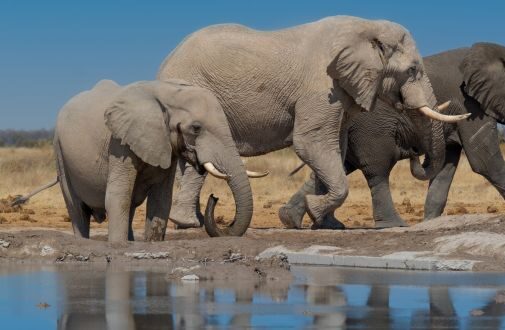available in Best Time to Visit
offering Safaris
Reserves and Wildlife
Areas
Namibia, one of the largest countries in the world, lies along the southwestern coast of southern Africa. Its three primary topographical regions – desert vegetation, savannah, and dry woodlands – are home to over 200 species of mammals. These enriching habitats are also home to more than 645 bird species and over 6,000 species of insects.
Namibia offers a splendid backdrop for scenic safaris and wildlife adventures such as whale watching at Walvis Bay, game viewing in Etosha National Park and bird watching at Caprivi Strip. To plan a trip to Namibia, you need to know the best time to visit so we’ll start by sharing the best time to visit Namibia’s four popular safari destinations.
Best Time To Visit Namibia: National Parks And Game Reserves
The table below denotes the best months to visit some of Namibia’s popular safari spots.
| National Park/Game Reserve | Best time to visit Namibia |
|---|---|
| Etosha National Park | July to October |
| Namib-Naukluft National Park | May to October |
| Skeleton Coast National Park | October to March |
| Popa Falls Game Park | June to September |
Namibia Through The Months
✔ October to March (Summer)
October is one of the ideal months to visit Namibia for game viewing. The rising temperatures contribute to the decline of vegetation, making it easier to spot the wildlife as it gathers around the depleting water sources and through the less dense vegetation. It is also the best month for whale watching at Walvis Bay.
From November to February, visitors can go bird watching along the Caprivi Strip, with the opportunity to see exotic birds such as the red-chested flufftail and three-banded courser. During these months, visitors can also head over to the lagoons in Swakopmund, where flamingos flock by thousands.
November can witness the first of the rains in short, sharp showers while January and February experience varying degrees of rainfalls in the afternoons, with days remaining hot and humid. These wet months in Namibia make it harder to spot the wildlife due to thicker vegetation and more water sources for the animals to drink at.
December is hot and humid, followed by the hottest month in the south being January while along the coast it’s February. As the rain falls, it nourishes the land, providing wildlife with numerous water sources so it disperses throughout the wilderness making it harder to see.
During these months, the desert temperatures can be the hottest in Namibia. An early morning visit to the desert during the summer offers visitors a stunning view of the rising sun.
✔ April to May (Autumn)
By April, the rains stop and the temperature drops in the evenings while the day time temperatures are ideal. The end of the rains is the most scenic time of year with the landscapes turning green and lush.
May marks the beginning of winter. It rarely rains during the month. It is an ideal time to visit the Namib sand dunes of Namib-Naukluft National Park,known for its impressive sand sea with its famous dunes at Sossusvlei along with fascinating Dead Vlei. Visitors can marvel at Kalahari’s rock formations and desert beauty.
✔ June to August (Winter)
Namibia experiences colder temperatures from June to August. The temperatures can drop below 10°C, with the desert experiencing freezing temperatures. Those who plan to visit during these months should pack plenty of warm clothing for the cold mornings and nights, particularly in the desert regions.
The winter months are the dry season in Namibia, offering great wildlife viewing opportunities for travellers in wildlife hotspots such as the remarkable Etosha National Park. The cooler months are also the best time to visit the Skeleton Coast, Luderitz and Kunene. The Skeleton Coast offers views of the memorable landscape formations and its famous coastline which caused many shipwrecks. In Luderitz, visitors can see the architecture, while in the remote northwest, spend time with the Himba people, learning about the local culture in the Kunene region.
✔ September (Spring)
September is the perfect time to visit Namibia before the temperatures hots up in October. The low humidity and no rainfall offer added incentives, making Namibia even more appealing and it’s a great time to visit all the top spots in Namibia, whether for impressive wildlife, spectacular scenery or fascinating culture. For example, plan a trip to Palmwag, a haven and peaceful locality known for its beautiful flora, while Caprivi Strip is Namibia’s bird paradise. Damaraland has many scenic wonders, Fish River Canyon is Africa’s largest canyon with amazing views and the shimmering salt pans of Etosha National Park are home to a wide range of wildlife.










